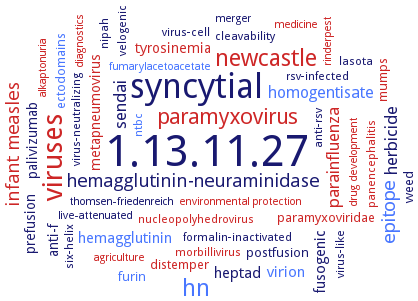1.13.11.27: 4-hydroxyphenylpyruvate dioxygenase
This is an abbreviated version!
For detailed information about 4-hydroxyphenylpyruvate dioxygenase, go to the full flat file.

Word Map on EC 1.13.11.27 
-
1.13.11.27
-
syncytial
-
viruses
-
newcastle
-
hn
-
paramyxovirus
-
epitope
-
hemagglutinin-neuraminidase
-
infant
-
measles
-
parainfluenza
-
herbicide
-
sendai
-
homogentisate
-
heptad
-
hemagglutinin
-
virion
-
fusogenic
-
tyrosinemia
-
metapneumovirus
-
prefusion
-
anti-f
-
palivizumab
-
weed
-
postfusion
-
paramyxoviridae
-
furin
-
distemper
-
ectodomains
-
mumps
-
virus-cell
-
rsv-infected
-
six-helix
-
cleavability
-
formalin-inactivated
-
lasota
-
virus-neutralizing
-
virus-like
-
morbillivirus
-
panencephalitis
-
ntbc
-
anti-rsv
-
nipah
-
velogenic
-
nucleopolyhedrovirus
-
drug development
-
alkaptonuria
-
diagnostics
-
thomsen-friedenreich
-
agriculture
-
environmental protection
-
rinderpest
-
live-attenuated
-
medicine
-
merger
-
fumarylacetoacetate
- 1.13.11.27
-
syncytial
- viruses
- newcastle
- hn
- paramyxovirus
- epitope
- hemagglutinin-neuraminidase
- infant
- measles
- parainfluenza
-
herbicide
-
sendai
- homogentisate
-
heptad
- hemagglutinin
- virion
-
fusogenic
- tyrosinemia
- metapneumovirus
-
prefusion
-
anti-f
-
palivizumab
-
weed
-
postfusion
- paramyxoviridae
- furin
- distemper
- ectodomains
- mumps
-
virus-cell
-
rsv-infected
-
six-helix
-
cleavability
-
formalin-inactivated
-
lasota
-
virus-neutralizing
-
virus-like
- morbillivirus
- panencephalitis
- ntbc
-
anti-rsv
-
nipah
-
velogenic
- nucleopolyhedrovirus
- drug development
- alkaptonuria
- diagnostics
-
thomsen-friedenreich
- agriculture
- environmental protection
- rinderpest
-
live-attenuated
- medicine
-
merger
- fumarylacetoacetate
Reaction
Synonyms
4-HPPD, 4-hydroxyphenylpyruvare dioxygenase, 4-hydroxyphenylpyruvate dioxygenase, 4-hydroxyphenylpyruvic acid dioxygenase, 4HPPD, ASJ32_19370, At-HPPD, AtHPPD, AvHPPD-03, EC 1.14.2.2, EC 1.99.1.14, formerly, F Alloantigen, F protein, F-antigen homolog, HPD, hpdA, HPPD, HPPDase, Legiolysin, MsHPPD, oxygenase, 4-hydroxyphenylpyruvate di-, p-hydroxyphenyl pyruvate dioxygenase, p-hydroxyphenylpyruvate dioxygenase, p-hydroxyphenylpyruvate hydroxylase, p-hydroxyphenylpyruvate oxidase, p-hydroxyphenylpyruvic acid hydroxylase, p-hydroxyphenylpyruvic hydroxylase, p-hydroxyphenylpyruvic oxidase, PTO1369, Pt_Hpd, T-cell reactive protein, TF-AG, YS103B


 results (
results ( results (
results ( top
top





